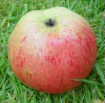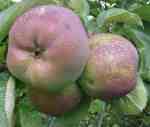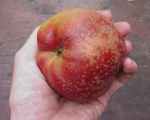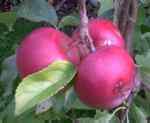
Apples not in the National Fruit Collection at Brogdale
I get a number of emails asking me if I can identify unknown apples, and sometimes people send me photographs. It's always interesting to see these, and make suggestions. But there is an angle which needs explaining...
The National Fruit Collection at Brogdale has about 2,000 varieties of apple. There's a waiting list of apples to go into the collection, and each time Brogdale decides apple X is no longer worthy of a place, it's chucked out and another one takes takes over. They have two trees of each type, on M9, and space limits them from having any more.
Now....there are about 22,000 villages in the UK. Most of them have an unknown apple or two. Here in Croft, Leicestershire, I know of three. One was grown from a pip by my neighbour (now aged 92); the others probably came from discarded apple cores, judging by where they're growing.
If most villages have a seedling apple tree, un-named apples probably outnumber named varieties by about 10 to 1. It's quite common for a child to grow a tree from a pip, for example....
Many of these apples have interesting or useful characteristics, and it was by collecting some of the best of them together that the Victorians formed the National Fruit Collection in the first place.
For interest I'm listing some of these "unknown" seedlings below, with pictures where I have them.
BLACK JACK
Colin Rudling, of Shermanbury, West Sussex, recently asked
"Have you heard of a Black Jack apple? .......
I wonder if you could identify it from this description ....over 50 years ago a neighbouring farmer
(at Shermanbury) had in his garden an apple tree which bore fruit
completely dark red and flattened. The most striking feature was
that it was very, very hard; these apples could be found on the ground
in March in perfect condition, and they could be eaten by cutting
thin biscuit sized slices. They were quite sweet, according to my
grandmother, and the tree kept the farm workers in apples right
though the winter and spring. The tree is no longer standing, but
we called the apples Black Jacks".
........if anyone knows about these apples, or if you
know of a grafted Black Jack tree still in existence, Colin and I would like to hear
from you........N.D..
UPDATE...I have been contacted by a person in Surrey, T.W.,
who knows a of a local Black Jack tree. He has kindly supplied
a sample, and Colin has has identified them as the apple he
remembers. He has also sent some pictures (many thanks):
FURTHER UPDATE: Colin and I have grafted a few
blackjack trees onto MM106.


I am grateful to Alison Lean of Brogdale, who has found one
reference to this variety - it
was apparently exhibited at an apple conference in Sussex in 1934 and
is described
as dark red, flattened and very acidic, though no mention is
made of its
extremely late season.
- Mel Wilson adds: there is a reference to this in HOGG's dictionary of apples:
WINTER COLMAN (Black Jack; Norfolk Colman ; Norfolk Storing]. Fruit, above medium size, three inches wide, and two inches and a quarter high ; roundish and flattened, obtusely angular on the side, and ribbed at the crown. Skin, yellowish green, with a tinge of dull red, on the shaded side, but deep dull mahogany brown on the side next the sun, which becomes clearer and more red as it attains maturity. Eye, with broad, erect, convergent segments, set in a rather shallow and plaited basin. Stamens, median, inclining to basal ; tube, conical. Stalk, short, thick, and deeply inserted. Flesh, firm, crisp, and briskly acid. Cells, round ; axile, closed.
A culinary apple of first-rate quality ; in use from November to April. The tree is a very strong and vigorous grower, so much so, that in its young state it is not a great bearer, but when grafted on the paradise stock it produces abundantly. (HOGG, 1884)
BURFORD RED
Very late, small, hard winter dessert apple found outside Burford, Oxfordshire,
January 2002; leaves all gone but tree still full of apples. Sweet, red-green to red;
hard texture, Cox-type flavour, smooth skin. Tree grafted; pictures
below.

Larger picture:
The tree, first season's fruit:
CROFT PIPPIN
Attractive dual purpose apple found in a private
garden in Croft, Leics. Original tree still standing.
This is less acidic than a Bramley, contains virtually no vitamin C, is a deeper red;
shiny skin, OK as a dessert apple from about October.
Round-conical in shape.
Picture: shows apple actual size.
Thumbnail picture below: 
CROFT LATE SEEDLING
From Croft, Leicestershire; a very late seedling found outside the old quarry gates. Small, red-blushed
apples which hang very late on the tree (sometimes late Jan), retaining a wonderful crunchy texture until mid-March or even
later. The flavour is of Cox type, though a bit weaker, but the texture, juiciness and keeping quality make
up for it. This is an excellent apple.
Thumbnail picture: 
For actual-size pictures, click on the following text:
Croft Late Seedling: : hard and crunchy Leicestershire apple, mid-Oct
Croft Late Seedling: on M26, Leicestershire - the tree, early November
Croft Late Seedling: - 12 weeks after picking, photo mid-Feb
The original tree still stands but it's badly overgrown and diseased. I have grafted numerous trees of "Croft Late" for friends, and some now grow in West Virginia, USA.
CROFT SHARP
This is a bittersharp cider apple originally found on the edge of Croft and from which I've propogated a few trees. It's a hard yellow cider apple of traditional type; small and inedible and highly scented. I took it to an apple identification event at HDRA a few years ago and the guy took a bite and had to spit it out. The cider apple exhibition at Brogdale in 2004 had one similar apple - "Fair Maid of Taunton", though the Croft apple is slightly more yellow and irregular.

Larger picture: - Bramley for scale.
DEER PARK APPLE
Quite late winter dessert apple, small, hard, found next to the Deer Park,
Witney, Oxfordshire, 2003. Tree grafted; pictures to follow soon.
Apples stay on tree until January. These apples are
rather like Ribston; a similar shape and colour
but smaller and a sweeter flavour.

DOCKNEY APPLE
According to an old Irishman from Armagh whom I used to
know, this variety stays on the tree for most of the
winter. He used it as a very late eating apple.
A Northern Ireland apple website gives the
following information: Flesh firm, greenish-white,
moderately juicy, not acid but with a pronounced tang.
Medium-sized roundish fruit. Greenish-yellow skin with
a brown-red flush. Thin russet dots, patches and
veining, with pearly white specks.
Firm flesh; cooks to sharp froth, also used for cider.
FOXTON'S FAVOURITE
This apple is not in the Fruit Collection; it is supposedly present in
Foxton, Leicestershire (where the locks are). Its special property
is, reputedly, that you can propogate it easily from cuttings. Break off a
scion, push it into the ground, and it grows. However after extensive
searching we have still not managed to locate a tree whose provenance is known.
"GEORGE'S RED APPLE"
Pictures sent to me in Feb 2005, by "George H.", living in Roundbush, Essex. with the following
message:
.............I have for the last 14 years worked to maintain an apple tree that to all intent and purpose should have been removed, but the little bit which is still growing is so attractive................
I looked at the attached pictures and I was immediately reminded of "Red Devil", which was bred about 30 years ago. But "G.H." continued.......
.............one of my neighbours told me that as a boy
he used to 'scrump' the apples from this tree and from another apple tree in
the back garden, this was about ten years ago and he was 92 at the time -
sadly now gone - making both trees more than one hundred years old. This is
further born out by the trees being used as a reference marker for boundaries in old
copies of the deeds.

More pictures of the fruit and blossom:
same picture as above, but bigger
Red blossom
Red blossom
Red leaves
Fruit, cut through.
Since 2006 there have been trees of this variety in the USA.
Red Devil, for comparision - an amazing sight....
MARTIN'S CUSTARD
See Leicestershire apples page. Culinary
/ dessert apple, believed extinct, rediscovered 2005.

MERE PIPPIN
Found at the roadside in Mere, Wiltshire, near Warminster. This is a very late apple which stays on the
tree, amazingly, until February. When I found this on Feb 15, 07, half
the apples were still on the tree. It has a most unusual flavour; very little acidity, and an interesting
hint of tropical fruit - perhaps custard apple - in its aftertaste and aroma. The flesh is unusually white, and very
firm; falling fruit don't bruise. I will be grafting Mere Pippin, as I've called it, this year. A rarity; my best
find since Whitwick Pippin.

VIRGINIA SWEET
American apple, not in any fruit collections, with unusual flavour ... discovered by Bill Mullins, W.V., USA.
Grafted by ND; not yet fruited, no pictures available.
Update, Sept. 07 - the tree contains a few big fruit. The flavour is extraordinary -
similar texture / density to Laxton's Fortune, but the taste contains a strong hint of
parma violets - I've never met this in an apple before. A most unusual, attractive fruit.
 ...
...

WHITWICK PIPPIN
Found in a private garden in Whitwick, Leicestershire...the peculiar property of this apple is that it
hangs on the tree almost indefinitely. I have a picture somewhere of blossom plus shrivelled apples on the
same branch. If netted against birds the fruit keep on the tree in good condition until early March. It's a
hard textured, long lasting, very late apple, dual purpose; edible as dessert from about Xmas Day. Similar in
character to "Croft Late Seedling" but stronger flavour, higher vitamin C and redder in colour. The finder of this
variety, Peter Edwards, wants the apple to be known as "Berkin Beauty", after the person who planted the
original pip in the mid-fifties. Unfortunately we don't know the parent apple.
A farmer, W.M., in the USA, West Virginia is now growing this variety. He sent an apple he'd found locally
in exchange: "Virginia Sweet" (q.v.).



WYGGESTON PIPPIN
This is, in a warm year, a good, rich flavoured
dual purpose apple with a smooth, matt skin which I found in a hedge
on the edge of the college grounds where I work (Wyggeston & Queen Elizabeth
College, Leicester). It's fairly early, with a peculiar shape, quite large,
and has a hint of crab apple in its flavour. In a cold year it's a
depressing, sour apple with a metallic edge to its taste; in the way that
Allington Pippin is disappointing when it's not had enough sun. W.P. in
these years is acidic and too sour to eat as dessert, and best used as an
early cooker. It responds well to a sunny site. Its main virtue is that the
tree is reliable; it's always loaded with fruit, which is why I propogated
it. Frequently one can find sextets of fruit just after fruit-set. It's also
a good early cider apple, taking the place of Bramley or Tom
Putt in a blend when not fully ripe .It ripens later than Devonshire Quarrenden and Merton
Knave but before Laxton's Fortune. On its own roots the tree is about the
size of unpruned MM106 or M11.
Picture: shows apple actual size.
Thumbnail pictures below:


This page isn't finished ... more information will be added as time permits.